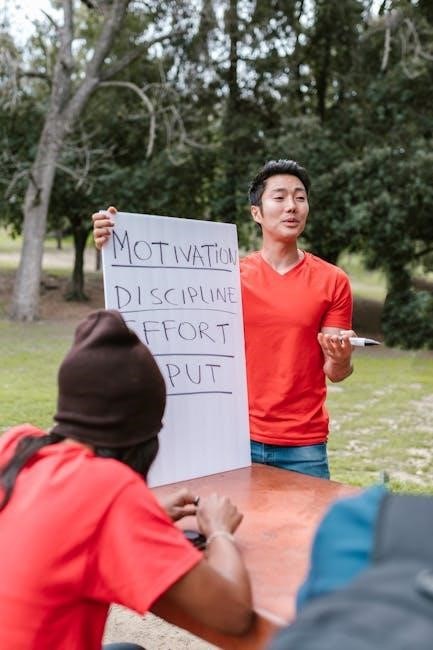navy prt failure instruction 2024
Navy PRT Failure Instruction 2024: A Comprehensive Guide
Recent Navy policy changes (June 2024) eliminate career-ending consequences for two consecutive PRT failures, focusing on remedial training and improvement plans for Sailors․
Understanding the Current PRT System
The Navy Physical Readiness Test (PRT) assesses Sailors’ physical fitness, crucial for operational readiness and naval service demands․ It comprises a 1․5-mile run, push-ups, and curl-ups, evaluating cardiovascular endurance, muscular strength, and core stability․ Scoring is age and gender-normed, with minimum passing standards established for each event․
Currently, the PRT is administered typically twice annually, though commands may conduct more frequent assessments․ A failing score initiates a cycle of remedial training and re-evaluation․ The system emphasizes improvement, offering resources like Command Fitness Leaders (CFLs) and Individualized Improvement Plans (IIPs)․ However, recent policy shifts, effective June 2024, significantly altered consequences for repeated failures, prioritizing retention and rehabilitation over separation․

Historical Context of Navy Fitness Assessments
Historically, Navy fitness assessments evolved from basic physical drills to standardized tests reflecting operational requirements․ Early assessments focused on swimming proficiency and general physical conditioning․ The introduction of the Physical Readiness Test (PRT) in 2000 marked a shift towards a more comprehensive evaluation of combat readiness․
Prior to 2024, a two-cycle failure of the PRT carried severe consequences, potentially leading to administrative separation or barring advancement and reenlistment․ This stringent policy aimed to maintain a physically fit fighting force․ However, concerns arose regarding its impact on Sailor retention and the fairness of the system․ The recent policy change reflects a move towards a more supportive approach, prioritizing remediation and recognizing the evolving understanding of fitness standards․
Recent Policy Changes (2024) Regarding PRT Failures
Significant changes to the Navy’s Physical Readiness Test (PRT) failure policy were implemented in June 2024․ The most notable shift eliminates the career-ending consequences previously associated with two consecutive PRT failures․ Sailors who fail twice will no longer be barred from advancement or reenlistment opportunities․
This policy revision emphasizes remedial training and individualized improvement plans (IIPs) as the primary response to PRT failures․ The Navy aims to provide Sailors with the resources and support needed to improve their fitness levels․ This change reflects a broader effort to retain qualified personnel and address concerns about the previous policy’s impact on Sailor careers and fleet readiness․

Consequences of Failing the Initial PRT
Initially, failing the PRT impacted advancement, reenlistment, and potentially led to administrative separation, though recent 2024 policy changes mitigate these severe outcomes․
Impact on Advancement Opportunities
Historically, a failed PRT significantly hindered a Sailor’s potential for advancement within the Navy’s ranks․ A failing score would often result in being ineligible for advancement to the next paygrade until successfully completing a subsequent PRT․ This created a substantial roadblock for career progression, delaying opportunities for increased responsibility and pay․
However, the recent policy shift in June 2024 has dramatically altered this landscape․ While a failed PRT still requires remedial training and a follow-up assessment, it no longer automatically bars a Sailor from consideration for advancement․ The Navy now prioritizes improvement and rehabilitation over immediate punitive measures, allowing Sailors a chance to demonstrate fitness gains and remain competitive for promotion opportunities․ This change aims to retain valuable personnel and foster a culture of wellness․
Reenlistment Restrictions Following a Failed PRT
Previously, failing the Physical Readiness Test (PRT) carried significant repercussions for Sailors considering reenlistment․ A failed PRT often resulted in an inability to extend an enlistment contract or to reenlist at all, potentially leading to separation from the Navy․ This created considerable anxiety for Sailors nearing the end of their initial obligation, as fitness directly impacted their long-term career path․
Fortunately, the updated Navy policy, implemented in June 2024, has removed this career-limiting restriction․ Sailors who fail the PRT are now eligible to reenlist, provided they actively participate in and complete a prescribed remedial training program․ The focus has shifted from automatic disqualification to a supportive approach, prioritizing fitness improvement and allowing qualified Sailors to continue serving their country․
Administrative Separation Potential
Historically, repeated failures of the Physical Readiness Test (PRT) could initiate administrative separation proceedings․ The Navy considered consistent inability to meet fitness standards as detrimental to military readiness, potentially leading to an other-than-honorable discharge․ This outcome carried severe consequences, impacting future employment and benefits․
However, the recent policy shift (June 2024) significantly reduced the likelihood of administrative separation solely based on PRT failures․ While consistent non-compliance with remedial training or a complete lack of effort to improve fitness could still contribute to separation proceedings, the Navy now prioritizes corrective action․ The emphasis is on providing opportunities for improvement before resorting to discharge, offering Sailors a chance to meet standards and continue their naval careers․

The Two-Cycle Failure Policy – Detailed Explanation
The two-cycle failure policy, as of June 2024, prevents career-ending consequences for Sailors failing two consecutive PRTs, prioritizing remediation and continued service․
What Constitutes a “Two-Cycle” Failure?
A “two-cycle” failure, under the revised Navy policy, specifically refers to failing the Physical Readiness Test (PRT) during two consecutive testing periods․ This doesn’t necessarily mean two tests within a single calendar year, but rather two failures across two separate, official PRT cycles․
The frequency of PRT cycles can vary; however, the policy applies when the Navy conducts two cycles annually․ It’s crucial to understand that a failure on the Body Composition Assessment (BCA) doesn’t automatically equate to a PRT failure, though both impact a Sailor’s overall fitness standing․ The focus has shifted from immediate punitive action to providing opportunities for improvement and remedial training following these consecutive failures, aiming to retain qualified personnel․
The Elimination of Career-Ending Consequences (as of June 2024)
As of June 2024, a significant shift in Navy policy occurred, eliminating the previous practice of barring Sailors from advancement or reenlistment after a second consecutive PRT failure․ This change represents a move away from punitive measures towards a more supportive approach focused on fitness improvement․
Previously, a second failed PRT could severely limit a Sailor’s career trajectory․ Now, the emphasis is on mandatory remedial training and individualized improvement plans (IIPs) designed to help Sailors meet fitness standards․ This policy change aims to retain valuable personnel and address fitness deficiencies through targeted support rather than immediate career repercussions․
Impact on Sailors Facing Potential Separation
The revised policy significantly impacts Sailors previously facing potential administrative separation due to repeated PRT failures․ While failing the PRT still carries consequences, immediate separation is no longer automatic after two consecutive failures․ This provides a crucial opportunity for those at risk to engage in remedial training and demonstrate improvement․
Sailors who were previously notified of potential separation proceedings may now have those proceedings paused or reconsidered․ The focus shifts to a structured improvement plan, offering a pathway to retain their Navy career․ However, continued failure to meet standards, even with support, may still ultimately lead to separation, but the process is now more deliberate and supportive․

Remedial Training and Improvement Plans
Mandatory programs and Individualized Improvement Plans (IIPs), guided by Command Fitness Leaders (CFLs), are now central to addressing PRT failures and boosting fitness․
Mandatory Remedial Training Programs
Following a failed PRT, Sailors are now required to participate in structured remedial training programs designed to address specific fitness deficiencies․ These programs aren’t simply about repeating the PRT; they focus on building foundational strength, endurance, and proper exercise technique․
Command-directed training will be tailored to individual needs, identified through a thorough assessment of the Sailor’s performance during the failed PRT․ Expect increased physical activity, potentially including extra physical training sessions, focused workouts, and nutritional guidance․ The goal is to equip Sailors with the tools and knowledge necessary to improve their fitness levels and successfully pass future PRTs․
These programs are closely monitored by CFLs, ensuring Sailors are actively engaged and making progress towards their fitness goals․ Successful completion of the remedial training is a prerequisite for retesting․
Individualized Improvement Plans (IIPs)
Beyond mandatory remedial training, Sailors facing PRT challenges may receive Individualized Improvement Plans (IIPs)․ These plans are collaboratively developed between the Sailor, their Chain of Command, and the Command Fitness Leader (CFL); IIPs represent a personalized approach to fitness improvement, acknowledging unique strengths and weaknesses․
An IIP details specific, measurable, achievable, relevant, and time-bound (SMART) goals․ It outlines a structured workout regimen, nutritional guidance, and regular progress check-ins․ The plan isn’t static; it’s reviewed and adjusted based on the Sailor’s performance and feedback․
IIPs emphasize accountability and provide Sailors with dedicated support to overcome fitness obstacles․ Consistent effort and adherence to the IIP are crucial for demonstrating commitment to improvement and achieving PRT success․
The Role of Command Fitness Leaders (CFLs)
Command Fitness Leaders (CFLs) are pivotal in supporting Sailors navigating PRT challenges․ They serve as subject matter experts on physical fitness, providing guidance on exercise techniques, nutrition, and injury prevention․ CFLs administer PRTs, ensuring standardized testing procedures are followed accurately and fairly․
Crucially, CFLs facilitate remedial training programs and assist in developing Individualized Improvement Plans (IIPs)․ They monitor Sailor progress, offering constructive feedback and motivation․ Beyond technical expertise, CFLs act as mentors, fostering a positive fitness culture within the command․

Effective CFLs proactively identify at-risk Sailors and intervene early, preventing potential PRT failures․ They are essential resources for maintaining fleet readiness and Sailor well-being․

Body Composition Assessment (BCA) and its Relation to PRT
Failing the BCA necessitates participation in a command-directed program; a BCA failure doesn’t automatically trigger PRT failure, but both impact overall fitness standards․
BCA Standards and Requirements
The Body Composition Assessment (BCA) is a crucial component of overall Navy fitness, evaluating Sailors based on height, weight, and body fat percentage․ Standards vary by gender and age, ensuring fairness and acknowledging physiological differences․ Sailors must meet established body fat limits, determined using either the method of circumference measurements or the height-weight standard․
Regular BCA participation is mandatory, typically conducted annually or upon return from extended duty․ Failure to meet standards initiates a corrective action plan, including nutritional guidance and increased physical training․ Repeated BCA failures can lead to administrative consequences, though recent policy changes (June 2024) emphasize remediation over separation․ Maintaining a healthy body composition is vital for operational readiness and long-term health․
Failing the BCA: Implications and Procedures
A failed BCA initiates a mandatory corrective action period, typically 30-90 days, focused on improving body composition․ Sailors receive individualized counseling on nutrition and exercise from Command Fitness Leaders (CFLs)․ During this period, regular progress assessments are conducted to monitor improvement․
Failure to meet BCA standards after the initial corrective period may result in continued counseling and a longer remediation timeframe․ While previous policy led to potential separation, current guidelines (June 2024) prioritize retention through intensive support․ Repeated BCA failures, despite intervention, can still impact advancement opportunities and reenlistment eligibility, though not automatically ending a career․
Relationship Between BCA Failure and PRT Failure
BCA and PRT failures are interconnected indicators of overall fitness, though assessed separately․ A Sailor struggling with the PRT may also face BCA challenges due to underlying physical conditioning or lifestyle factors․ Conversely, failing the BCA can negatively impact PRT performance, hindering stamina and strength․
The Navy recognizes this relationship, often implementing combined remedial plans addressing both areas․ While a single BCA failure doesn’t automatically trigger a PRT re-test, consistent issues with body composition can signal a broader fitness deficiency․ Current policy (June 2024) emphasizes holistic improvement, avoiding punitive measures unless repeated failures demonstrate a lack of effort․

Appealing a PRT Failure
Sailors can appeal a PRT failure by submitting documented evidence, following a step-by-step process, and citing valid grounds like testing errors or extenuating circumstances․
The Appeal Process: Step-by-Step Guide
Step 1: Initial Notification & Counseling․ Upon failing the PRT, Sailors receive official notification and mandatory counseling from their command․ This session clarifies the failure and outlines appeal rights․
Step 2: Documentation Gathering․ Collect all supporting documentation – medical records, injury reports, or evidence of extenuating circumstances impacting performance․ Thorough documentation is crucial․
Step 3: Written Appeal Submission․ Prepare a formal, written appeal outlining the reasons for contesting the results․ Address it to the designated authority within the chain of command․
Step 4: Command Review․ The command reviews the appeal and supporting documentation․ They may request additional information or conduct further investigation․
Step 5: Higher Authority Review․ If the command denies the appeal, it can be escalated to a higher authority for review․ This ensures a fair and impartial assessment․
Step 6: Final Decision․ The final decision is communicated in writing, outlining the rationale behind the outcome․
Required Documentation for a Successful Appeal
Medical Documentation: Crucially, include records of any pre-existing conditions or injuries impacting PRT performance, verified by a medical professional․ This demonstrates legitimate physical limitations․
Injury Reports: Submit official injury reports (NA Form 553) detailing the nature, extent, and treatment of any injuries sustained before or during the PRT․
Command Counseling Records: Provide copies of all counseling sessions related to fitness, improvement plans, and any command-directed remedial training․
Statements of Support: Include statements from witnesses (e․g․, CFLs, medical personnel) corroborating the Sailor’s claims or providing relevant context․
Extenuating Circumstance Evidence: Document any significant personal or professional stressors impacting fitness levels, such as deployments, family emergencies, or temporary duty assignments․
PRT Scorecards: Copies of the original PRT scorecards are essential for verifying the reported results and identifying potential errors․
Common Grounds for PRT Appeal
Incorrect Scoring: Discrepancies in event scoring, such as miscounted repetitions or inaccurate timing, represent valid appeal grounds․ Detailed documentation supporting the correct score is vital․
Faulty Equipment: If malfunctioning equipment (e․g․, treadmills, pull-up bars) demonstrably affected performance, this warrants an appeal, alongside evidence of the equipment issue․
Medical Condition: Undiagnosed or inadequately addressed medical conditions limiting physical ability constitute legitimate grounds, requiring supporting medical documentation․
Improper Test Administration: Violations of PRT standards during administration, like inadequate warm-up or improper form correction, can be appealed․
Administrative Error: Mistakes in paperwork, data entry, or reporting procedures impacting the PRT result are valid appeal reasons․
Extenuating Circumstances: Documented significant life events impacting fitness, like deployments or family emergencies, may support an appeal․

Resources for Sailors Struggling with the PRT
Sailors can access the Navy Fitness website, Fleet and Family Support Centers, and mental health services for PRT-related support and guidance․
Navy Fitness Website and Resources
The official Navy Fitness website serves as a central hub for all Physical Readiness Test (PRT) related information․ Sailors can find detailed guidance on PRT standards, scoring, and proper exercise techniques․ This online resource provides access to training programs designed to improve performance in each PRT event, including the curl-up, push-up, and 1․5-mile run․
Furthermore, the website offers educational materials on body composition assessment (BCA) requirements and healthy lifestyle choices․ It also features frequently asked questions (FAQs) addressing common concerns about the PRT and BCA processes․ Sailors can utilize these resources to proactively prepare for assessments and address any fitness-related challenges they may encounter․ Regularly checking the Navy Fitness website ensures access to the most current policies and guidance․
Fleet and Family Support Center Assistance
Fleet and Family Support Centers (FFSCs) offer invaluable support to Sailors navigating challenges related to the Navy’s PRT requirements․ FFSCs provide personalized counseling services to address stress, anxiety, and other emotional factors that can impact fitness performance․ They also host workshops on goal setting, time management, and healthy lifestyle habits, empowering Sailors to take control of their physical readiness․
Moreover, FFSCs can connect Sailors with resources for financial counseling and nutritional guidance, recognizing that overall well-being is crucial for PRT success․ These centers serve as a confidential and supportive environment where Sailors can seek assistance without fear of reprisal, fostering a proactive approach to fitness and readiness․ FFSCs are a vital component of the Navy’s commitment to Sailor support․
Mental Health Resources for Fitness-Related Stress
The pressure surrounding the Navy’s PRT can significantly impact a Sailor’s mental well-being, leading to stress, anxiety, and even depression․ Recognizing this, the Navy provides numerous mental health resources to support Sailors facing these challenges․ Military OneSource offers confidential counseling services, available 24/7, via phone, online chat, or video conferencing․
Chaplains also provide a safe and non-judgmental space for Sailors to discuss their concerns․ Additionally, the Navy’s Behavioral Health clinics offer specialized care from licensed professionals․ Seeking help is a sign of strength, and utilizing these resources can empower Sailors to manage stress, improve their mental resilience, and ultimately enhance their overall fitness journey․

Future Outlook: Potential Changes to the Navy PRT
Ongoing discussions focus on PRT reform and incorporating modern fitness science․ Potential changes may include new standards, aiming for a more holistic and effective assessment․
Ongoing Discussions Regarding PRT Reform
Currently, the Navy is actively evaluating the Physical Readiness Test (PRT), considering adjustments to better reflect the demands of modern naval service․ These discussions stem from feedback regarding the test’s effectiveness and fairness, alongside the recent policy shift regarding two-cycle failures․
Key areas of consideration include the potential for a more comprehensive assessment that incorporates elements beyond the traditional push-ups, sit-ups, and run․ There’s exploration into functional fitness components, mirroring real-world operational requirements․ The goal is to create a system that accurately gauges a Sailor’s ability to perform their duties effectively and safely․
Furthermore, the Navy is examining ways to personalize fitness programs and provide more targeted remedial training, ensuring Sailors receive the support needed to meet standards․ This ongoing evaluation demonstrates a commitment to Sailor well-being and operational readiness․
Potential Implementation of New Fitness Standards
The Navy is contemplating a shift towards fitness standards that more closely align with the physical demands of various ratings and operational environments․ This could involve tiered standards, recognizing that the fitness requirements for a surface warfare officer differ from those of a culinary specialist․
Discussions include incorporating assessments of strength, endurance, agility, and mobility, potentially moving beyond the current PRT’s focus on three core exercises․ The integration of technology, such as wearable fitness trackers, is also being explored to provide more objective and continuous monitoring of Sailor fitness levels․
Any new standards would likely emphasize functional fitness, preparing Sailors for the challenges they face in real-world scenarios․ The aim is to enhance overall readiness and reduce injury rates, fostering a healthier and more capable fleet․
The Influence of Modern Fitness Science on Navy Policy
Modern fitness science is increasingly shaping Navy policy regarding physical readiness, moving away from traditional, generalized assessments․ Research highlights the importance of individualized training programs tailored to specific physiological needs and operational demands․
The Navy is examining the effectiveness of various training methodologies, including high-intensity interval training (HIIT) and functional movement screening, to optimize Sailor performance and minimize injury risk․ Understanding the impact of sleep, nutrition, and stress management on fitness is also gaining prominence․
This scientific approach supports the recent policy shift away from punitive measures for PRT failures, emphasizing remedial training and improvement plans grounded in evidence-based practices․ The goal is to cultivate a culture of fitness that prioritizes long-term health and readiness․






































































